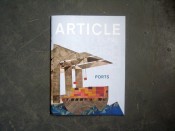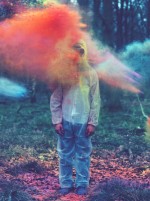October 2011
September 2011
August 2011
July 2011
June 2011
May 2011
April 2011
March 2011
February 2011
December 2010
November 2010
October 2010
September 2010
August 2010
July 2010
May 2010

|
Art Sarah Abbott Interview
April 23, 2011 Self proclaimed glass-half-empty artist/illustrator from Rotherham; making an impact with her melancholic ‘What Now?’s and habitual greys and blues… |
Work by artist / illustrator Sarah Abbott dreamily harks back to classic 50s American advertising and design, with an injection of contemporary folk. There are woodland animals in shirts, repeated sprigs of foliage and portraits of herself and friends, enveloped in chic, delicate forms and neutral colour blocks. She lives and works in Sheffield, a city abundant in illustrators, artists and designers working as actively in their studios as out of them, in galleries, bars, gig venues and spaces where the public can watch.

Abbott showcases her work via a website and blog for her work as it emerges, a shop on Etsy for her prints, and exhibitions from Manchester’s FFAF, East Gallery London to Rotherham’s Old Market Gallery. Even her own arm shows off an example of her illustrative talent with a pinecone tattoo.

Do you aim to build a fictional narrative and how far do you let reality inform what you draw?
There was a time when I couldn’t draw much without a reference, I find it quite difficult to imagine things in my head. I like to make things that appear familiar to people and for them to relate to it. My work is very much based in reality.
Do you like to tell a story through your work?
More a sense of trying to convey a mood or a feeling. It’s only recently that I’ve started to bring human characters into my work and I think that helps people connect and see a story unfolding.
There’s recent revival of retro print designs by many retailers, and I think your work bears similarities to elements of this era in design. Who or what would you cite as your main inspiration?
Most of my inspiration comes from the Internet (not so retro!). I enjoy some good vintage rummaging. I like the look of old hand painted signs and advertisements. I find it hard to pinpoint specific influences because there are so many. I really enjoy the work of American artists Jim Houser and Margaret Kilgallen who both have a great eye for colour, typography and shape.
But what I like about their work most of all is their need to take it beyond the page, often working onto walls, onto streets, or creating objects and environments, creating a new world to step into or experience; something I’d love to do more of myself.
Like in the 50s where advertisements showed us the best side of everything, your work delivers dreamy idealism and escapism. Is this why your work is now so appealing?
It’s a balancing act for me, not making something too hopeful versus something that’s bit of a downer. I’m reluctantly a glass half empty person so there tends to be a melancholic, uncertain edge to things I make. Even optimistic subjects have a grey flatness hinting at something not quite right. I think they succeed because everyone shares that feeling.
You’re in the Digital Artist Magazine ‘Creative Hotlist 2011’, that’s so great! Is it hard to decide whether to hand draw an illustration or turn to your computer?
I don’t really sit and make a decision about it. Ultimately for me the work will end up in a digital format so things that start out as hand drawn images still end up being worked with on the computer. Generally I mix the two.
After studying Printmaking at Manchester Met University do you prefer manually printing your work?
This is a bit of a sore area. Even when studying print it was a recurring joke that I didn’t do much of it. You have to be very patient with screen printing and it can be a messy process of trial and error. When I kept a sketchbook at University my mistakes would get ripped right out. I’ve learned to let myself off a little bit now though (mostly).
The muted quality of your work is like a consistently attractive modesty. Is it a conscious restriction?
Colour (or lack of colour) is really important for me. I like to keep things subtle and only add colour sparingly for the most part. Colour decisions are very similar to those you make when deciding if a piece is finished and it’s easy to get carried away with it. I’d much rather someone came across my work like a quiet conversation, rather than it shouting out to them as if to say ‘here I am, look at me!’.
Take a look at Sarah Abbott’s website and blog.
Interview by Jane Faram










